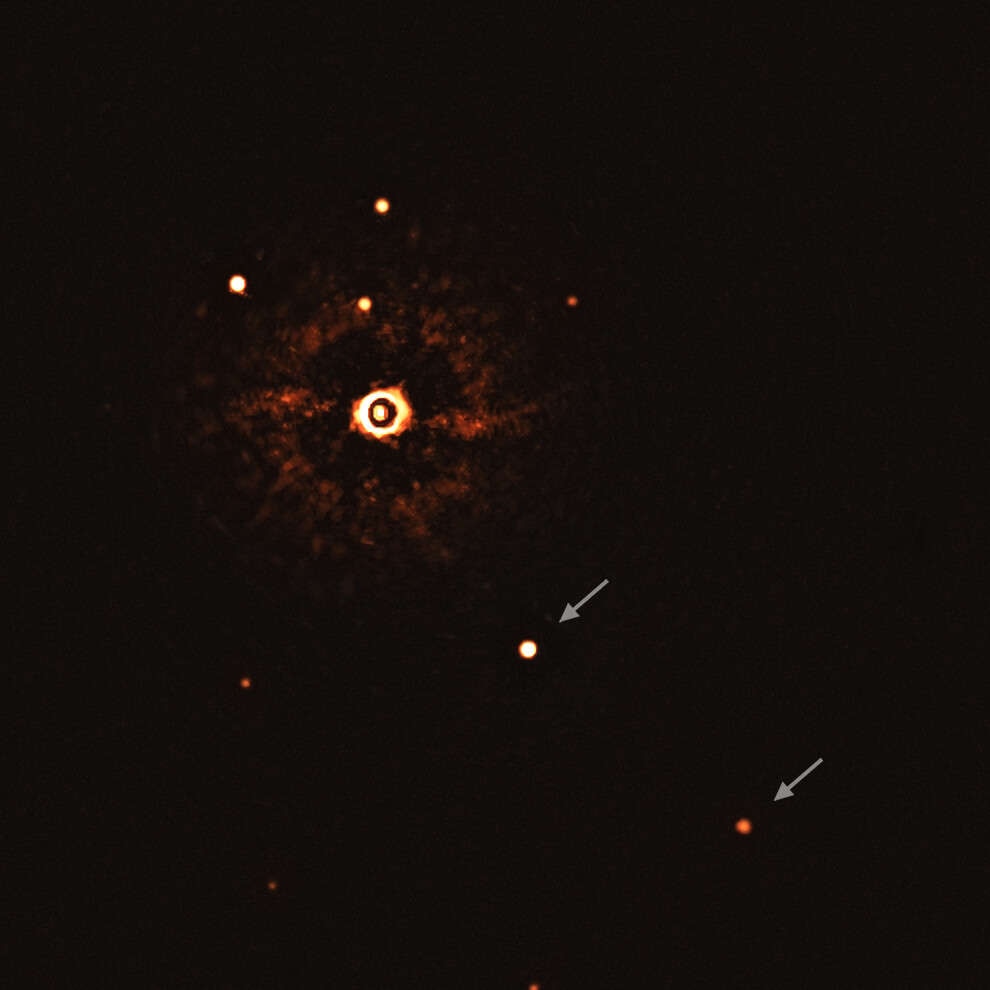Create a free profile to get unlimited access to exclusive videos, sweepstakes, and more!
An exoplanet first: Two giant planets directly imaged around a young Sun-like star

In an exoplanetary first, astronomers have directly imaged two giant planets orbiting a star that’s a virtual twin of the Sun — though much younger.
The star is called TYC 8998-760-1 (after its ID number in the Tycho catalog), and it’s about 310 light years away in the constellation of Musca. It’s part of a group of stars all born together called the Scorpius-Centaurus Association, which is handy because we know those stars are all very young; the age of this star is only about 17 million years. The Sun is 4.6 billion years old, over 250 times this star’s age.
It also allows astronomers to calculate the star’s mass, which is — get this — 1.00 ±0.02 times the Sun’s, meaning it is almost exactly the same mass as the Sun. That means that it’s a virtual twin of the Sun, if way younger, and studying it gives us hints on what things may have been like for the Sun when it was an infant.
Earlier in 2020 astronomers found a giant planet orbiting the star (called TYC 8998-760-1b, so let’s just call it “planet b”). It’s really far out, over 24 billion kilometers, or 162 times the Earth-Sun distance, and has a mass of about 14 times Jupiter’s. Many of the same astronomers then found a second planet around the star (“planet c”), even farther out: nearly 50 billion kilometers, 320 times the Earth-Sun distance, and with a mass about 6 times Jupiter’s.
They’re so far out that the glare from the star is reduced considerably, and that means they both show up in an actual image taken of the star:
Coooooool. Only two other multiplanet star systems have been directly imaged — HR 8799 and PDS 70 — but the former is quite a bit more massive than the Sun, and the latter substantially less, making this new one a relevant system to study, especially since the planets and their configuration are so different to our own.
The star itself has most of its light blocked by a coronagraph, a disk of metal in the middle of the camera’s field of view, reducing its glare substantially, allowing the much fainter planets to be seen.
At this age, planets are still glowing due to the heat from their formation, making them bright in the infrared, where these images were taken. Planet b is more massive, so it’s hotter and glows more brightly.
So how do they know these are planets and not background stars or very distant galaxies? To check, they compared observations of the star taken about three years apart. The star is actually moving through space rapidly enough that over this time its motion is easily detected relative to background objects. If the two objects were planets they’d move with the star, and if they were background stars we’d see the star move quite a bit relative to them.
The objects did in fact move with the star! That means they are real, bona fide planets.
It’s very interesting indeed that the planets are so far from their star. Neptune is about 6 billion kilometers from the Sun, roughly 30 times the Earth-Sun distance, so these two planets are really far out. It’s not clear how such massive planets could form that far from the star.
The astronomers looked at orbit simulations and found that if the two have nearly circular orbits then they’re stable for a timescale of a billion years at least, in which case they did form that far from the star. If instead they’re more elliptical, the orbits are not stable over that time. In that case it’s still possible they formed out there, but it’s also possible they used to orbit closer in and encountered a more massive planet, and this caused them to be flung out to great distances, where we see them today.
That’s very interesting. There’s an idea that there used to be five gas giants in our solar system (Jupiter, Saturn, Uranus, Neptune, and a fifth one). Early on the fifth one got too close to Jupiter and the gravity from the immense planet ejected it. This idea explains some weird features in our solar systems configuration; it’s not proven but there’s indirect evidence supporting it. We can’t prove it because the smoking gun — the fifth planet — is gone. But here we see another system with a star almost exactly like the Sun, and two planets really far out, possibly ejected. That makes the local fifth planet idea a little more compelling.
This technology to image exoplanets is pretty new, and, like these observations show, you sometimes have to wait a few years to make sure you’re seeing planets. But this shows we can, and that means we’ll find more.
We see planets everywhere, and with a bewildering variety of characteristics, but soon I bet we’ll see systems that look very much like our own, too. Whether they do, or look entirely alien, we still learn important things about our own home. I’m good with it either way.



























